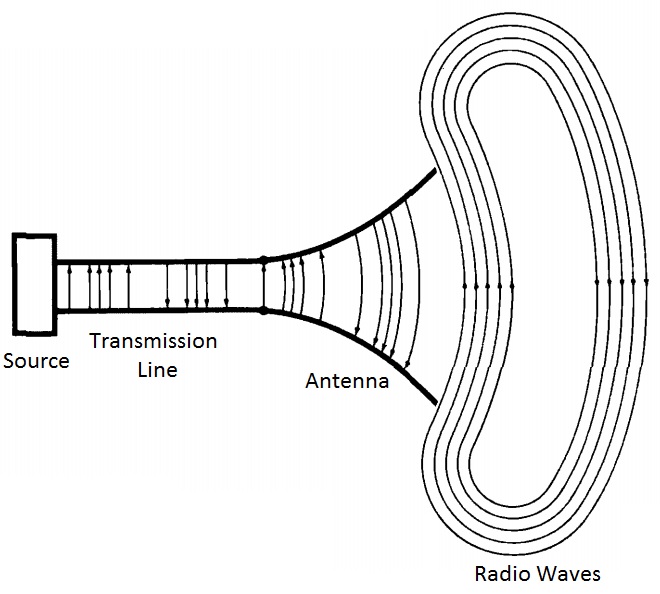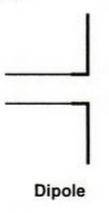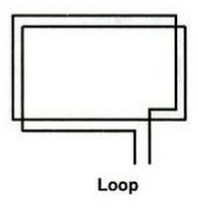If you are interested in Wireless Communication Engineering, there will be a time where you will come across designing or working with antennas. Irrespective of the field of interest, I hope that this tutorial on Antennas and different types of Antennas will be useful to even a non-technical person. Important Note:
There is a whole lot of complex mathematics involved in the theory of Antennas beginning with electromagnetic waves, Maxwell’s Equations, power patterns, radiation etc. Discussing those is out-of-scope of this tutorial as this is just an introductory work.
Antennas are Everywhere
You might be familiar with antennas in general whether or not you understand the working of an antenna. Where ever there is Wireless Communication, there is an Antenna. The shape, size and type of antenna might be different but there is an antenna involved none the less. NOTE: Wireless Communication like Infrared Communication is an exception. For example, consider the two of the most important devices in our life: A Mobile Phone and a Television (or simply T.V.). Both these devices rely on wireless communication and hence both these devices must somehow have an antenna associated with them. NOTE: Cable T.V. is not discussed here even though there is an antenna involved (usually with the operator, who receives the signal with the help of antenna and transmit them through a co-axial cable). In fact, both these devices and many other wireless devices like Routers, Wireless Modems, Game Controllers, Bluetooth Devices (like headphones), etc. essentially have an antenna in one way or other.
So, what is an Antenna?
An Antenna is a structure affiliated with the region of transition between the “guided wave” and “free space”. Okay, this is definitely not a good definition for a beginner. Let me put it this way: An Antenna (or sometimes called as an Aerial), is an electrical device that converts electric power into electromagnetic waves (or simply radio waves) and vice-versa. A signal from a transmission line or the guiding device (hence the term guided wave) like a co-axial cable, is given to an antenna, which then converts the signal into electromagnetic energy to be transmitted through space (hence the term free space).
Antenna can be used for both Transmission and Reception of electromagnetic radiation i.e. a Transmitting Antenna with collect electrical signals from a transmission line and converts them into radio waves whereas a Receiving Antenna does the exact opposite i.e. it accepts radio waves from the space and converts them to electrical signals and gives them to a transmission line.
Why do we need Antennas?
There are several reasons as to why we need or why we use antennas, but an important reason as to why we use antennas is that they provide a simple way to transfer signals (or data) where other methods are impossible. For example, take the case of an aeroplane. The pilot needs to frequently communicate with the ATC personnel. If would not make any sense if we tie up a cable (of dynamically variable length) to the tail of the plane and connect it to the ATC. Wireless communication is the only feasible option and Antennas are the gateway for that. There are many situations or applications where cables are preferred over wireless communication with antennas (like high speed ethernet or the connection between gaming console and the T.V., for example).
Different Types of Antennas
Now that we have seen a little bit about antennas in general and why do we use antennas, let us proceed further and take a look as different types antennas. There are several types of antennas and each literature work has its own classification of antennas. Some of the common types of antennas are mentioned below:
Wire Antennas Short Dipole Antenna Dipole Antenna Loop Antenna Monopole Antenna Log Periodic Antennas Bow Tie Antennas Log-Periodic Antennas Log-Periodic Dipole Array Aperture Antennas Slot Antenna Horn Antenna Microstrip Antennas Rectangular Microstrip Patch Antenna Quarter-Wave Patch Antenna Reflector Antennas Flat-plate Reflector Antenna Corner Reflector Antenna Parabolic Reflector Antenna Lens Antennas Travelling-wave Antennas Long Wire Antenna Yagi–Uda Antenna Helical Wire Antenna Spiral Antenna Array Antennas Two-Element Array Antenna Linear Array Antenna Phased Array Antennas
Let us now briefly see about few of these different types of antennas. Wire Antennas One of the most commonly used antennas are wire antennas. They can be found in vehicles (automobiles), ships, aircrafts, buildings etc. Wire Antennas come in different shapes and sizes like straight wire (Dipole), Loop and Helix. Short Dipole Antenna Perhaps the simplest of all antennas is the Short Dipole Antenna. It is a special case of the Dipole antenna. In its simplest form, it is basically an open circuit wire with the signal being fed at the centre. The term “short” in short dipole antenna doesn’t directly refer to its size but rather to the size of the wire relative to the wavelength of the signal.
For a typical Short Dipole Antenna, the length of the wire les less than the tenth of the wavelength of the frequency of operation. Dipole Antenna A Dipole Antenna is made up two conductors in the same axis and the length of the wire need to be small compared to the wavelength. Loop Antenna A Loop antenna is formed by a single or multiple turn of wire forming a loop. The radiation produced by loop antenna is comparable to a short dipole antenna.
Monopole Antenna A special case of Dipole antenna is the monopole antenna i.e. it is half of the dipole antenna. Aperture Antennas A class of directional antennas, Aperture Antennas have an opening in the surface. Usually, aperture antenna consists of Dipole or Loop Antenna in a guiding structure with an opening to emit radio waves. Slot Antenna A type of aperture antenna which contains one or more slots cut on the surface of the waveguide. They are usually used in microwave frequencies and have an omnidirectional radiation pattern. Horn Antenna One of the most popular antennas is the Horn Antenna, which effects the transition between transmission line and wave propagating in free space. It acts as a natural extension to a waveguide.
Fundamental Parameters of Antennas (Characteristics)
By now, we have a basic understanding of an antenna and how it is an essential component in a Wireless Communication system. The next important thing to understand is that the characteristics of a typical wireless communication system are dependent on the characteristics of the antenna used in the system. For example, the operational characteristics of a communication system find back its roots to the directional characteristics of the antenna. Irrespective of the application that an antenna is used in, all the antennas are associated with a few fundamental parameters. These parameters are sometimes also called as Properties of Antenna or Characteristics of Antenna. Certain basic characteristics of antenna are listed below:
Antenna Radiation Pattern Radiation Intensity Directivity and Gain Radiation Efficiency and Power Gain Input Impedance Effective Length Bandwidth Effective Aperture Antenna Polarization
Let us understand these properties of antennas one-by-one.
Radiation Pattern
A practical antenna cannot radiate energy in all directions with equal strength. Radiation from an antenna is usually found to be maximum in one direction whereas it is minimum or almost zero in other directions. Field Strength is the quantity that is used to represent the radiation pattern of an antenna. It is usually measured at a point located at a particular distance from the antenna. You can measure field strength by calculating voltage at two different points on an electric line and dividing the result with the distance between the two points. Hence, the units of field strength are volts per meter. Graphically speaking, the field of strength is plotted as a three-dimensional graph as it is the measure of the electromagnetic field strength at equidistant points from the antenna. If the graph of radiation of antenna is just a function of direction, then it is simply called as Radiation Pattern. But if it is expressed in terms of the electric field strength in V/m, then it is called Field Strength (or Radiation) Pattern. The following image shows the Field Radiation Pattern for Dipole Antennas with half wavelength and one wavelength.
Sometimes, the radiation of the antenna is also a function of the power per unit solid angle. This graph is called as Power Radiation Pattern.
Radiation Intensity
The radiation intensity of an antenna is the power per unit solid angle. It is represented by U and is independent to distance from the antenna. Units of radiation intensity are Watts per steradian (W/Sr).
Directivity and Gain
Ideally, an antenna which radiates energy in all directions equally i.e. an omnidirectional antenna is called as Isotropic Antenna. This is just a hypothetical situation and an isotropic antenna doesn’t exist in practice. But if we consider an isotropic antenna, then its power density will be same at all points on the sphere of radiation. Hence, the average power of an antenna as a function of radiated power is Pavg = Prad / 4πr2 W/m2 The ratio of power density to the average power radiated is known as Directive Gain. Directivity of an Antenna is a measure of concentration of radiation in the direction of maximum radiation or the ratio of maximum power density to average power radiated.
Radiation Efficiency and Power Gain
All practical antennas will have Ohmic losses as they are made up of conducting materials with finite conductivity. Radiation Efficiency is ratio of radiated power to the input power. ηr = Prad / Pin Power Gain of an Antenna is the ratio of the power radiated in a direction to the total input power.
Input Impedance
We should take care to match the input impedance of the antenna to that of the input transmission line. If the input impedance doesn’t match, then the system degrades over time due to the reflected power.
Effective Length
The length of an imaginary linear antenna with uniformly distributed current is defined as the Effective Length of an antenna such that both these antennas have same far field in π/2 plane.
Bandwidth
The bandwidth of antenna is defined as the range of frequencies over which the characteristics of the antenna are maintained to the specified value. This is because, the requirements for the characteristics of an antenna like the gain, impedance, standing wave ratio etc. may change during operation.
Effective Aperture
Generally, the term effective aperture or effective area is associated with the receiving antenna. Effective Aperture or Area of an antenna is the measure of the ability of an antenna to extract energy from the electromagnetic wave. Effective Aperture of an antenna is the ratio of the Power Received at the load to the average power density produced by the antenna.
Antenna Polarization
The Antenna Polarization refers to the physical orientation of the electromagnetic wave radiated in a given direction. Polarization of an EM Wave is a time varying direction and relative magnitude of the electric field vector. If the direction is not specified, then the polarization in the direction of maximum gain is considered. There are other characteristics like Antenna Temperature, beamwidth, beam efficiency etc. which are also critical. Your website is an excellent effort to bring basics of wireless systems from industry perspective. Perhaps it deliberately avoided equations. But some resources such as generation of wave patterns such as: ———————————- AT&T archives: Similarities of wave behavior (Bonus Edition), April 3, 2012. https://www.youtube.com/watch?v=DovunOxlY1k ——————————– could be included to allow readers to “see” the waves and some of its aspects observed visually. Comment * Name * Email * Website
Δ










![]()